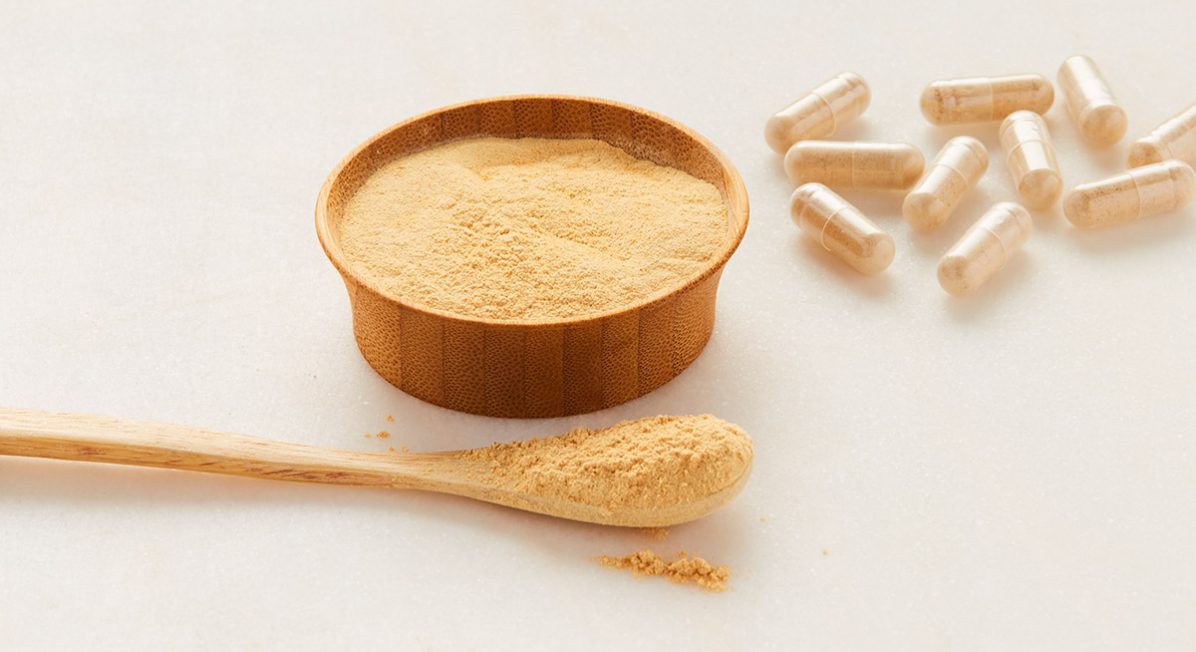Your New Guide to Superfoods: Adaptogenic Herbs, Mushrooms & More
Last Update: November 21, 2024
When the term superfood first started getting a bit of buzz, it described a food that was especially loaded with nutrients—things like antioxidants and omega-3 fatty acids that support human health.
Amid the wellness boom, the superfood category grew to include not just fruits, vegetables, and fish, but also things like functional mushrooms, adaptogenic herbs, and deep sea algaes, plants that have been used for thousands of years to improve human health in various forms. Now that they’re available in convenient forms like supplements, powders, snacks, and tinctures, these ancient remedies have gained appeal for a whole new audience. Though if you’re wondering what makes them so super—well, you can thank Mother Nature for that one.
What are superfoods?

“Superfood” generally refers to a food that is exceptionally nutrient dense. While no food is a miracle cure, the list of superfoods includes things like salmon (rich in omega-3 fatty acids), blueberries (high in antioxidants), and almonds (packed with plant protein).
So-called superfoods may include larger-than-average quantities of things like:
- Antioxidants
- Fiber
- Protein
- Omega-3 fatty acids
- Vitamins
- Minerals
Whether you’re looking to up your intake of essential nutrients or to test-drive a natural remedy for stress, here’s a handy guide to some of the most incredible superfoods the Earth has to offer.
Superfood Fruits

What are superfood fruits?
You’re certainly familiar with blueberries, but some of the most nutrient-dense superfood fruits are far less common. While fruits are all fairly high in nutrients, some are more worthy of the superfood title.
What makes them super?
Most fruits are generally high in fiber, which makes them a filling snack that’s good for your digestive system. The most super of superfood fruits are also incredibly high in antioxidants, which help to protect cells against free radicals and may help your body fight off disease.
Types of superfood fruits:
- Goji berries: Loaded with antioxidants that have a positive effect on vision and immunity
- Golden berries: High in antioxidants and phenolic compounds that may prevent against cancer, according to certain studies
- Acai berries: Filled with antioxidant-rich polyphenols that that reduce inflammation and improve cardiovascular function
- Amla (or Indian Gooseberry): Rich in vitamin C, which can prevent cell damage and slow signs of aging in the skin, hair, and vision
- Cacao: High in flavanols, which are antioxidants that may prevent against cancer
How to eat superfood fruits:
- Blended in smoothies
- On their own as a snack
- In trail mix
- As a topping for oats or granola
- In salads
- To give desserts a healthy boost
Recipes with superfood fruits:
Frosé With Goji Berry Simple Syrup
Superfood Hot Chocolate with Acai and Goji Berries
Acai Beauty Bowl
Superfood Seeds

What are superfood seeds?
A seed is the starting point of a plant, but it’s also a super nutritious food in its own right. Seeds are, quite literally, embryonic plants covered in some type of hard outer shell, though they come in a wide variety of shapes and sizes, from tiny chia seeds to snack-sized sunflower seeds.
What makes them super?
Seeds contain things that plants need to grow, such as fiber, monounsaturated fats, vitamins, minerals, and disease-fighting antioxidants. While the health benefits of each seed vary, certain types may help to reduce blood pressure and other risk factors for heart disease.

Types of superfood seeds:
- Chia: The richest plant source of omega-3 fatty acids
- Flax: Each serving provides more than 10% of your daily protein; regulates digestion; reduces risk factors for heart disease
- Quinoa: Contains quercetin and kaempferol, flavonoids that studies show to have anti-inflammatory, anti-viral, anti-cancer and anti-depressant effects

How to eat superfood seeds:
- Blended in smoothies
- Soaked overnight to create a pudding
- As a type of milk
- In place of eggs for baking
- Toasted and used as a topping
Superfood seed recipes:
Pumpkin Quinoa Pancakes
Coffee Chia Pudding
Hemp Macadamia Raw Bars
Superfood Roots

What are superfood roots?
Medicinal roots have been used in herbal medicine for thousands of years, and for very good reasons. These knotty, strangely shaped roots add a strong flavor to your cooking (or your smoothie), and they’re loaded with beneficial nutrients.
What makes them super?
Certain roots offer powerful anti-inflammatory and antioxidant effects, thanks to bioactive compounds like gingerol (found in ginger) and curcumin (found in turmeric). These also help to naturally soothe nausea, lower cholesterol, and improve brain function.

Types of superfood roots:
- Ginger: Powerful antioxidant and anti-inflammatory properties, thanks to gingerol
- Turmeric: Powerful antioxidant and anti-inflammatory properties, thanks to curcumin
- Maca: Natural energy boost; may improve fertility

How to eat superfood roots:
- Dried in powder form
- Minced or diced to flavor while cooking
- Brewed into tea
- Sprinkled in baking
- In capsule form (as a supplement)
Superfood root recipes:
Maca and Raspberry Smoothie
Turmeric Wellness Tonic
Superfood Golden Milk Smoothie
Functional Mushrooms

What are functional mushrooms?
Certain types of mushrooms provide more than just nutrition and earthy, umami flavor. These functional (also called medicinal) mushrooms are believed to positively impact your overall health in addition to simply providing you with essential nutrients.
Why are they super?
True to their name, functional mushrooms are shown to provide some sort of function, like combating inflammation or fighting off disease. Certain types of functional mushrooms may even offer mood-boosting benefits, helping the body to ward off stress and increasing your resistance to anxiety.

Types of functional mushrooms:
- Reishi: Supports the adrenal glands, which secrete cortisol to help the body regulate stress
- Lion’s mane: Shown to modulate BDNF, a stress-regulating protein essential for brain function
- Cordyceps: Shown to improve stress response and decrease fatigue, according to certain studies
How to eat functional mushrooms:
- Sauteed as a side dish
- In pastas
- Infused in teas or other beverages
- In powder or supplement form
- In soups
- Taken as a tincture

Functional mushroom recipes:
Pumpkin Reishi Soup
Mushroom Toast
Vegan Mint Hot Chocolate with Functional Mushrooms
Adaptogens

What are adaptogens?
Looking for a natural way to combat stress? Adaptogens may be the key—and these superfoods are easy to add to any diet. Adaptogens are herbs, plants, and mushrooms that have long been used in holistic medicine practices for their regulatory effects on the body.
Why are they super?
Adaptogenic herbs and plants don’t just provide essential nutrients, but also offer normalizing effects that help your body to balance stress, alleviate symptoms of anxiety, and decrease fatigue. Adaptogens are shown to regulate cortisol levels and support the central nervous system, which may make them a great natural way to combat stress.

Types of adaptogenic herbs and plants:
- Ashwagandha: Used for thousands of years to relieve stress and naturally increase energy and focus
- Matcha: High in antioxidants, which help to prevent cell damage
- Shatavari: May help prevent cell damage and reduce stress
- Holy basil: Different parts of the plant used for different purposes, including treating skin conditions, nausea, depression, and sleep issues

How to eat adaptogens:
- As a supplement
- In powder form
- Mixed in coffee or tea
- To season other foods
- In smoothies
Adaptogen recipes:
Ashwagandha Moon Milk
Blueberry Mint Beauty Spritzer
Seaweed and Algae

What is superfood seaweed?
It’s not exactly the seaweed that you see during a trip to the beach, but it does often come from the same place. Superfood seaweeds, sea vegetables, and algaes come in a variety of sizes and types, and they can be consumed in a variety of ways.
Why is it super?
Superfood algae and seaweeds are dense in nutrients, which means you get a lot of nutritional bang for your buck from a very small serving. They offer a variety of vitamins and minerals, and most types contain iodine and amino acids to regulate thyroid function and antioxidants to help prevent diseases.
Types of superfood seaweeds and algae:
- Spirulina: Considered one of the most nutritious foods the planet based on the amount of protein, B vitamins, copper, and iron packed into a small serving
- Nori: Supports thyroid function through high amounts of iodine and tyrosine
- Chlorella: Contains high amounts of antioxidants that prevent damage to cells
How to eat seaweed and algae:
- In pill or powder form
- As a wrap for sushi or vegetables
- Dried as a chip-like snack
- Blended in superfood smoothies
- As a detoxifying drink
- To season food (similar to an herb)

Seaweed and algae recipes:
Nori Chicken Wrap with Sushi Rice
Roasted Broccolini with Nori Salt
Avocado Pesto Pasta with Chlorella
Blue Spirulina Smoothie
*Consult your doctor before adding any supplements or herbal remedies to your diet.
Download the app for easy shopping on the go
By providing your mobile number, you agree to receive marketing text messages from Thrive Market. Consent not a condition to purchase. Msg & data rates apply. Msg frequency varies. Reply HELP for help and STOP to cancel.
This site is protected by reCAPTCHA and the Google Privacy Policy and Terms of Service apply.